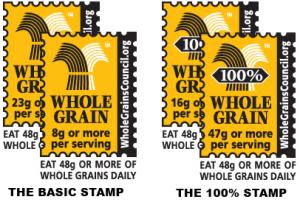Buyer Beware! Whole Grain Stamp Doesn’t Tell Whole Story
A new study out yesterday found that using the whole grain stamp to identify healthy foods didn’t always work in the buyer’s favor.

The whole grain stamp, a packaging symbol awarded to foods by the non-governmental Whole Grain Council, can help buyers quickly identify foods that have at least 8 grams of whole grains per serving.
But the study, from Harvard, found that foods with this stamp often had more sugar and more calories than foods without the stamp. The group looked at 545 products to determine the health value of those with the stamp and without.
The good news is that items with the stamp were higher in fiber and contained less trans fat, but the higher levels of sugar and calories outweigh the benefits of the fiber.
The group also looked at several other ways of identifying healthy whole grain foods. The USDA’s MyPlate recommendation is to look for foods that have whole grain as the first ingredient without added sugars in the first three ingredients. Another recommendation, from the American Heart Association, is to look for a ratio of carbohydrate to fiber that’s less than 10:1 (meaning that 10-20% of the carbs are fiber).
While the first recommendation didn’t prove to be a good guide for buyers, the 10:1 ratio turned out to be the best bet when trying to purchase overall healthy foods. Items that met this ratio had more fiber and less trans fat, sugar, and sodium. They also did not have as many calories as products that did not meet the ratio.
So next time you’re out buying healthy food for your family, don’t just go for the whole grain stamp, but check out the nutritional label to make sure at least 10-20% of the carbohydrates are fiber.
Read more about whole grains.
